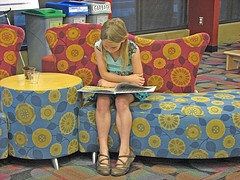How Online Professional Development Changed My Life
February 12, 2013
This post originally appeared on the NCTE Inbox blog. I happened upon it today and found myself reminiscing on the paths that I’ve traveled to get to who I am. I thought I’d copy it over to my site to make sure I didn’t lose it. I edited it to remove dated references
Chances are high that you wouldn’t be reading this if it weren’t for online professional development. I don’t mean that in the clichéd “If you can read this thank a teacher” way. What I mean is that I would never, ever have had the connections that led to writing these blog entries if it hadn’t been for the online professional development opportunities that came my way.
People who know me may not believe it, but I kept to myself as a teacher before I found opportunities to connect with other educators online. I read a lot about teaching, but I rarely discussed teaching strategies with others. I had some connections in the department where I taught, and I was a fellow of Writing Project site that no longer exists.
And then I got an email address and found that other college composition teachers were out there discussing what they do in the classroom online. I signed up Megabyte University, an email discussion list that was active from 1990 to 1997. There, I connected with other teachers who were interested in using computers in writing instruction, and I eventually found my voice and began participating–asking questions, sharing strategies, and planning projects. I found that the people who were names on the articles I read in College English and College Composition and Communication were kind, friendly folks who were willing to chat with a relatively inexperienced person like me.
To my conversations on email discussion lists, I added real-time chats on MOOs and IRC. I attended online conferences related to the face-to-face Computers and Writing Conference. Before I knew it, I had connections with colleagues in all corners of the country, and I had actually chatted with CCCC presidents and NCTE Committee Chairs. I even got up the gumption to send a personal email message to Peter Elbow to tell him how much I loved Writing with Power.
Without any reservation, I can say that I ended up writing this blog because of those first connections that I made online in the early 1990s. Online discussion led to new jobs, new teaching opportunities, and new ways to support other teachers using online tools.
None of the resources I tapped when I got started still exist in the same form today. Computer resources have evolved, and we teachers have developed new ways to connect and keep in touch today. Today we have new ways of keeping in touch, like discussion lists, Twitter Chats, and Facebook Groups. You’ll find wonderful teachers who will share their ideas, listen to your strategies, and, if you’re just lucky, bring you opportunities that will invigorate your teaching every day.






